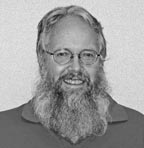Ananda Ashrama – Part 2

president of the Historical Society
of the Crescenta Valley and loves local history. Reach him at
lawlerdad@yahoo.com.
Last week I wrote about Swami Paramananda coming to America from India, his establishment of the Vedanta Centre in Boston, and then his expansion to California in 1923 with the purchase of a ranch in La Crescenta. Swami Paramananda and his philosophy of Vedanta already had a good following from his many lecture tours around the U.S., and California was fertile ground for spiritual messages such as this. Paramananda initially conducted services and lectures from the stone farmhouse that had been the main house for the ranch, but soon the swami and members of the church embarked on an ambitious building campaign. The original farmhouse was expanded to house the monks and nuns, and cabins were built for devotees. A large three-story building, the Paramananda House, was built for visitors seeking spiritual retreat, and roads were laid throughout the complex. The extensive plantings were expanded, and hives were built for bees. The Ashrama had talented volunteers for their building plans, including the assistance of two noted California architects – J. Constantine Hillman, famed Pasadena Craftsman builder, and Elmer Grey, designer of the Huntington Art Gallery, Pasadena Playhouse and Beverly Hills Hotel. George Weigland, foreman of the Pasadena Ice House, oversaw all construction.
The crowning achievement for both Swami Paramananda and his many volunteers was the construction of the Temple of the Universal Spirit, completed in 1928. A large Mission-style church was constructed facing into an inner courtyard, surrounded by arched covered walkways. The interior of the temple was paneled in redwood, with painted borders of mountain buckwheat. Famed artist Jessie Trueworthy painted ceiling murals and inscriptions throughout. Set into the interior church walls were several niches, each of them individually dedicated to one of the world’s great religions. Above were the tall stained glass windows, again each depicting the edifices of the world’s religions – Christian cathedral, Hindu temple, Shinto shrine, Jewish synagogue, Moslem mosque and others. And through those images of the different faiths shone the light from one sun – in the same way that, claimed Swami Paramananda, the one God illuminated man through all religions.
The services and classes held at the Temple attracted many followers from the arts – for example actress Greta Garbo, modern dancer Ruth St. Denis, and writer Thomas Mann. At the Ashrama, crafts were practiced such as weaving and making incense from mountain herbs. Besides the orchards and gardens that were tended on the property, cows and chickens were raised. It was quite a paradise!
Although the Ananda Ashrama was surrounded by the beauty and bounty of nature, it was also visited with nature’s wrath. In November 1933 a massive fire swept the front of the San Gabriel Mountains burning many homes on the fringes of the mountainside. The Ashrama stood squarely in the path of the roaring flames, and the fierce wind-driven fire passed over and around the Ashrama. Swami Paramananda was staying at the Boston Vedanta Centre and endured the agony of hearing on national news that “the entire ‘Hindu’ community in La Crescenta” had been killed. The earth was charred for 360 degrees around the property, but the Ashrama and its occupants were left untouched, like an oasis in a scorched desert. A minister from the Church of the Lighted Window in La Cañada described it as a divine miracle. (I’ll recount this dramatic “Miracle of La Crescenta” in an upcoming column.)
Six weeks later the Ashrama was again left as an oasis amid destruction when the great New Year’s flood passed on either side, leaving the Ashrama intact.
The last test for the Ashrama occurred in 1940, when Swami Paramananda died. Paramananda had always ignored gender in the leadership structure of his organization, and when he died he left two women to carry on his work. The mother organization in India decreed that every branch center must have a male swami in charge. After much soul-searching, the Sisters of Swami Paramananda’s organization rejected the edict. They would continue without the support of their parent Order, and they have done so since.
They still thrive today – an unusual independent spiritual order run entirely by women.
Next week – Ananda Ashrama today.
